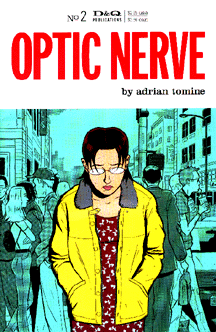

[ Metro | Metroactive Central | Archives ]
Optical Sandman
In praise of Adrian Tomine's 'Optic Nerve' and Charles Vess' new 'Sandman'
By Richard von Busack
"The book you hold in your hand would not exist had high school been a pleasant experience for me." So reads the first sentence in 32 Stories (Drawn & Quarterly Press; $9.95), a reprint collection of Adrian Tomine's first, self-published Optic Nerve minicomics. The statement is doubly telling. First, it draws the line between the average Joe and the Optic Nerve reader, the latter being someone who failed to regard high school as a wonderful place full of swell folks. Second, it implies its reverse: I would rather have had a good time in high school than have written this book.
Tomine worked his way up from photocopied comics that he couldn't give away in his native Sacramento to a handsomely produced autobiographical comic book reviewed in Spin, whose critic made the easy but obvious comparison to Raymond Carver. The latest issue, Optic Nerve #2 (Drawn and Quarterly; $2.95), shows all of Tomine's strengths: illustrations fretted over for maximum realism in cityscapes and faces; the lack of huge epiphanies; gentleness and sensitivity.
I admire Tomine's work abstractly, though, and I wish there was more in him of the kid that wants to burn that high school down. As 32 Stories shows, Tomine was more aggrieved than he first let on. He evinces a forcefulness, an urge to make his mark, that was absent from the too-soft Optic Nerve #1.
The second installment of Optic Nerve contains Tomine's best work, especially in his longest tale to date: the story of a summer job in a photocopy place. For some added irony, the hero's put-upon quality is emphasized as he weathers the weary jokes of the lifers and steals paper to put out a sad little zine with "Sacramento Sucks" scrawled on the cover. One co-worker, a wizened young girl named Maureen, not only believes that Procter & Gamble is run by Satanists but also that the president of the company boasted about it on Donahue: "He said he doesn't mind telling because there's not enough Christians to make a difference."
Comics appeal to us not only with their caricatures, revenge themes and cruel humor but also with their renderings of moods and silences. Judging a younger artist--Tomine is only 21--is as much a matter of seeing where the trajectory might head as it is of noting where it is now.
As an artist, Tomine has made remarkable leaps, and he's learning as a writer and toughening up his attitude. With the professional packaging, he has made Optic Nerve alluring to 20-somethings who wouldn't pick up autobiographical comics before.
The realm of fantasy always does seem to pale in comparison to the far-weirder theater of real life. Still, Charles Vess is one of the best artists working in fantasy. Vess (who will appear at Lee's Comics in Palo Alto on April 21) demonstrates his talent in two highly recommended new comics.
His self-published The Book of Ballads and Sagas (Green Man Press; $2.95) illustrates several medieval ballads. It is a fine idea for a comic, since these songs, handed down through the centuries, are always as mysterious for what they leave in as what they leave out.
One ballad is scripted by Neil Gaiman, with whom Vess has collaborated on the last issue of Sandman Comics, Sandman #75: The Tempest (Vertigo; $3.95). It is a sort-of sequel to the Sandman story about A Midsummer Night's Dream and a last encounter between Shakespeare and his master, the Sandman, a.k.a. Morpheus, King of Dreams.
Little is known about Shakespeare's life, but it's generally thought that the final scene of his last play, The Tempest, in which Prospero renounces his own magic, was meant to be autobiographical.
Gaiman's account of the story is flavored by his own quitting of a splendid comic that was the biggest and best the art form had to offer. It's to DC/Vertigo's credit that they are retiring the series rather than trying to carry on without Gaiman.
Gaiman's words and Vess' art evoke the weak face, perplexed life and subversive purpose of an underestimated man who gets a last chance to ask his muse why he was chosen for his gifts--a question no doubt asked by the real Shakespeare, envying "this man's art and that man's scope," just as it is asked by a bright high-school kid.
[ Metro | Metroactive Central | Archives ] This page was designed and created by the Boulevards team.

From the April 11-17, 1996 issue of Metro
Copyright © 1996 Metro Publishing and Virtual Valley, Inc.